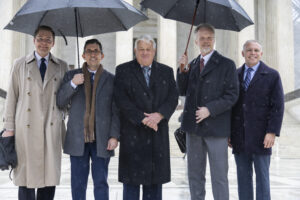The constitutionality of legislatively imposed exactions

“Where once government was closely constrained to increase the freedom of individuals, now property ownership is closely constrained to increase the power of government. Where once government was a necessary evil because it protected private property, now private property is a necessary evil because it funds government programs.”
[1]San Remo Hotel L.P. v. City and County of San Francisco (Brown, J., dissenting).
Those words by former California Supreme Court Justice Janice Rogers Brown ring as true today as when she wrote them in 2002.
The ownership of property encompasses a variety of rights, including the right to possess, occupy, devise, sell, rent, and—often, most importantly—the right to use. But those rights have limits. When the use of property can cause harm to others, the government has the power to restrict that use.
Thus, government can prevent land uses that would otherwise cause flooding to neighbors, create noxious odors, or directly injure neighbors. Government also has another option: Instead of preventing the harmful use outright, it can impose conditions or “exactions” that mitigate the harm. For example, if the use of property will cause excessive noise, a government can require the landowner to build a sound wall. Or it may require the owner to dedicate land for a sound buffer.
Similarly, instead of asking for a project like a sound wall or land for a buffer, government may demand money that will be used to prevent the harm. For example, if building a new apartment building will create new traffic impacts, the government may demand money for road improvements.
But with the power to demand exactions of land or money comes responsibility not to abuse that power. Unfortunately, some government bodies have treated their power to grant and deny permits as an excuse to treat homebuilders and land developers like ATM machines. That is why Pacific Legal Foundation attorneys have travelled to the Supreme Court three times just to limit permit exaction abuse.
‘Out-and-out plan of extortion’
In 1982, when PLF clients Patrick and Marilyn Nollan sought a coastal development permit to replace a run-down one-story bungalow with a two-story home along Faria Beach in Ventura County, the California Coastal Commission pounced. For years, the agency had been eyeing beachfront property along the entire coast so it could create a long public beach where there was private property. But it didn’t want to pay a dime for untold millions of dollars in real estate from the Mexican border to Oregon. It had a better plan—demand landowners to give up their property in exchange for permits.
The Nollans needed a permit to build, and the Commission wanted their land for free. So the Commission told the Nollans that if they wanted a permit, they had to agree to give up one-third of their modest lot.
The Nollans sued, arguing that the Commission was taking their property in violation of the Constitution. PLF represented the Nollans free of charge. After losing in the California courts, we took the case to the Supreme Court.
The Commission tried to defend itself by saying that the Nollans’ new home would make it more difficult for motorists to see the ocean. The home, in the Commission’s words, would create a “psychological barrier” to the coast. The Supreme Court was unconvinced. In the Court’s 1987 decision in Nollan v. California Coastal Commission, Justice Antonin Scalia observed that forcing the Nollans to give up their land wouldn’t help motorists see the ocean. Instead, the Court called the scheme an “an out-and-out plan of extortion.”
The Court held that government could no longer demand a permit exaction unless that exaction had a “nexus” or relationship to a harm that a use of property would cause. But that didn’t stop governments from trying to abuse their permitting power.
The next time the issue reached the Supreme Court was in Dolan v. City of Tigard, a case where PLF was a friend of the Court. In that case, Mrs. Florence Dolan wanted to enlarge her plumbing supply store and pave 39 parking spaces. But the City of Tigard had other plans. It demanded that she give up a public riparian easement and construct a bike path near her property. The City argued that there was a nexus—that her parking lot might cause river flooding and that the expansion might increase traffic. When the Supreme Court took the case, it was unconvinced.
The Court said that the City had to prove not only that there was some connection between the development and the exactions, but it also had to prove they were “roughly proportional” to the impacts. This, the Court said, was a requirement of the “doctrine of unconstitutional conditions”—meaning that government cannot demand that someone give up a constitutional right (here the right to just compensation for a taking of property) in exchange for a permit to use property.
Two Supreme Court victories for property owners were not enough to deter some government agencies. Reasoning that in Nollan and Dolan the Court struck down exactions of land, some agencies tried demanding money instead.
The Court put a stop to this end-run in 2013 with its decision in Koontz v. St. Johns River Water Management District. That saga began in 1972 when Coy Koontz, Sr. applied for a permit to develop a small shopping center on a portion of a 14.9-acre parcel near the intersection of two major roadways near Orlando, Florida. He agreed to give up 11 acres of wetlands in order to get a permit from the water management district. But that wasn’t enough. The District demanded that Koontz also finance the improvement of the drainage on some District-owned property over five miles away, at a cost of up to $150,000. Koontz refused, and the District denied the permit.
Coy Koontz then sued, arguing that the demand constituted a taking in violation of Nollan and Dolan. The litigation outlasted Coy Koontz, Sr. His son, Coy Koontz Jr., carried on with the litigation. He lost at the Florida Supreme Court. First, that court found that because the permit had been denied, no condition had actually been imposed. Second, the court ruled that demands of money weren’t subject to Nollan and Dolan. PLF took over the case and went to the U.S. Supreme Court.
The Supreme Court reversed. All members of the Court agreed that a governmental body cannot avoid scrutiny under Nollan or Dolan simply through the expedient of denying a permit when the owner refuses to accede to the demanded exaction. And a majority of the Court concluded that because money is a form of property, just like land, a government that demands an exaction of money in exchange for a permit must prove the nexus and rough proportionality standards as required by the doctrine of unconstitutional conditions.
The government gets creative
But, if nothing else, government agencies are creative. Their next attempt to do an end-run around these rules is now before the Court in another PLF case, Sheetz v. El Dorado County. Noting that the government losses in Nollan, Dolan, and Koontz occurred in the context of the administrative permit process—that is, exactions imposed by bureaucrats—the latest ploy is to argue that exactions imposed by legislative bodies are immune from the doctrine of unconstitutional conditions.
George Sheetz sought a permit to put an 1,854-square-foot manufactured home on ten acres in a rural part of El Dorado County, just east of Sacramento. But the county demanded that he pay $23,400 in “traffic mitigation” fees, including $2,260 to improve a highway interchange four miles from his property. Sheetz argued that the County couldn’t do this because it hadn’t even tried to meet its burden under Dolan to prove the money demand was roughly proportional to any traffic his small home would cause.
The County responded that it didn’t have to prove anything because the traffic mitigation fees weren’t calculated during the permit process, but were derived from a map previously approved by the County Board of Supervisors. The County argued this was a legislative act, rather than a bureaucratic administrative one, and therefore subject to lower scrutiny. Remarkably, the California courts agreed with the County.
Now, before the Supreme Court, George Sheetz is arguing that all exactions—administratively and legislatively concocted alike—are subject to the doctrine of unconstitutional conditions. In support, Sheetz’s attorneys point out there are many instances where the doctrine of unconstitutional conditions has been applied to legislative enactments. For example, the Court previously struck down restrictions on free speech imposed by legislative bodies as a condition of receiving government permits and benefits.
Moreover, in Nollan, Dolan, and Koontz, the exactions that the government agencies attempted to impose were all authorized by legislation. The distinction between administrative and legislative exactions is meaningless, Sheetz argues.
When the Supreme Court heard the oral argument in George Sheetz’s case in January, there were many questions about whether there is a difference between exactions of money, user fees, and taxes. The answer is yes, because exactions are imposed where the government has power and leverage over an owner seeking permission to use and develop property. Therefore, such exactions must be justified by government. Interestingly, during argument, even the attorney for the County seemed to recognize that legislative exactions might be subject to the standards of Nollan, Dolan, and Koontz.
Perhaps a victory in this case will mean this will be the last time PLF must go to the Supreme Court to put a stop to unlawful exactions. We are expecting a decision by June.










